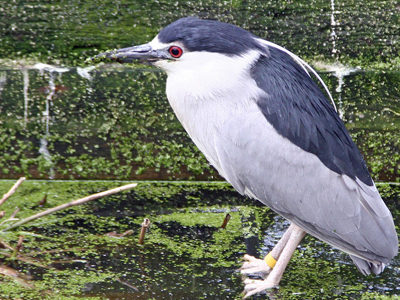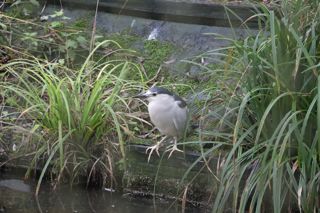
Night Heron
Nycticorax nycticorax
Small member of the heron family (average weight of 800g and around 64cm long), they appear much stockier and have shorter bills. When resting they have a “hunched” appearance, standing tall only when hunting.
Their distinguishing feature is their plumage which comprises of a black head cap and back, contrasted with a white or grey body, wings and underparts. From the back of their head, grows two or three long white plume feathers which are used in courtship and greeting displays. They have red eyes and yellow legs.
Behaviour
Social all year round, form mixed and same species colonies when nesting. Both sexes can be territorial over feeding and nesting areas. Breeding nests are constructed on or above dry ground near water in bushes, reed beds, and cliff edges
Sticks and other plant vegetation is used as nesting material, with the birds creating a nesting “platform”. Night herons are “ambush predators” standing still at the water’s edge, occasionally even using lures to attract or distract fish. Unlike other herons, has the visual capacity to hunt at night, hence the name.
UK Status
Historically has always been a visitor to the UK, although not known to breed here. In 2017, a pair of Night Herons successfully bred in the UK for the first time in Somerset. The increase in conservation management, particularly of wetland areas in the UK could be the reason we may see more black capped night herons breeding here in the future.
Threats
Habitat destruction of wetland habitats due to drainage, as well as pollution from pesticides are main causes for concern for night heron populations worldwide. Their predatory habits of fish can lead them into conflict at fish stocks where they are actively persecuted, in addition to this they are also hunted and traded for food and medicine internationally in Africa and Asia.

Distribution
Wide global distribution. Europe, Asia and Africa are all areas that provide breeding colonies of Night Herons. Are also found in North and South America. North populations are migratory, with European populations wintering in Africa and southern Asia.
Habitat
Freshwater and saltwater wetland habitats such as marshes, swamps, tidal mudflats, salt marshes and wet agricultural fields. Relatively dense vegetation needed for cover, roosting and nesting such as mangroves and oak forest margins.
Diet
Opportunistic predator of both aquatic and terrestrial animals. Main food items include crustaceans, insects, fish, amphibians, lizards, birds and eggs. Plant material and carrion are also occasionally consumed.
Wildwood inside information
We are home to one Black-Capped Night Heron, who can be found in our mixed species Ken West Aviary, home to our choughs, avocets and little egrets.
Family facts
As a defense mechanism, young Night Herons spew their stomach contents when alarmed.
-
![Night Heron 2]()
Wildwood animal adoptions last for one year and are the perfect gift for any animal lover. Each adoption helps support our work to save British wildlife. We have different levels of adoption available to suit all occasions and budgets.
ADOPT ME!
-
![Night Heron 2]()
Find out how you can support our conservation work and join our fight.
Support us

